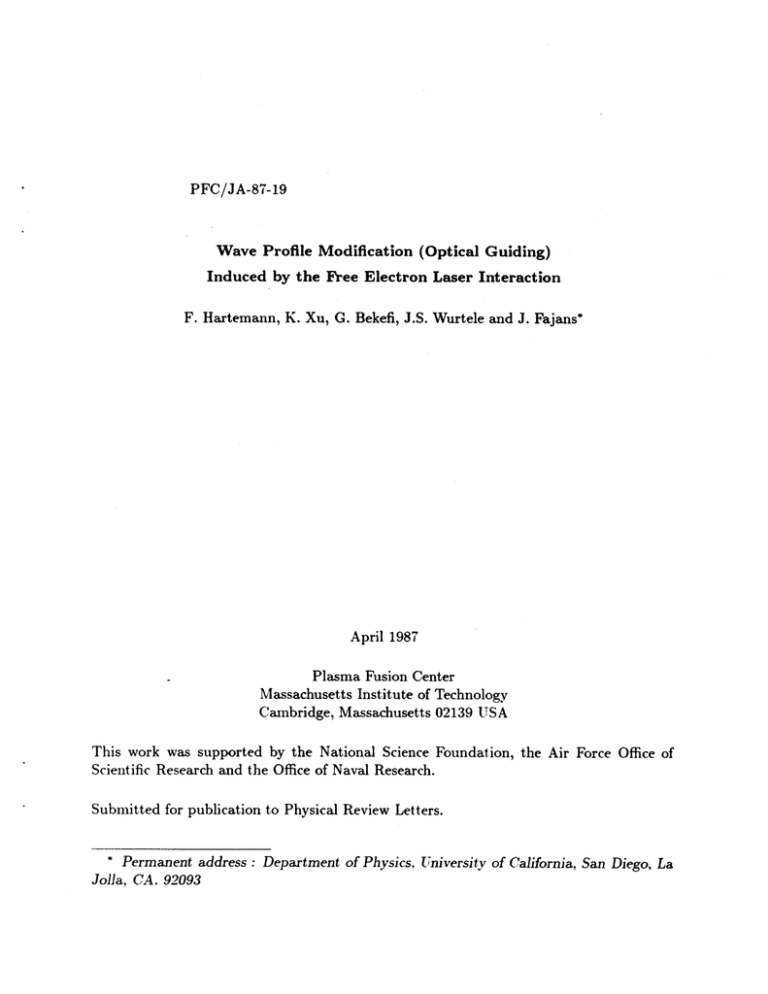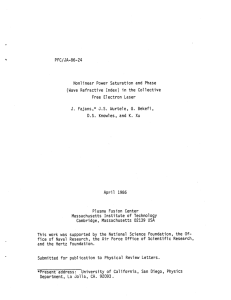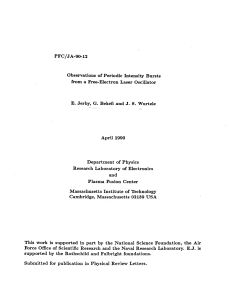PFC/JA-87-19 Wave Profile Modification (Optical Guiding)
advertisement

PFC/JA-87-19 Wave Profile Modification (Optical Guiding) Induced by the Free Electron Laser Interaction F. Hartemann, K. Xu, G. Bekefi, J.S. Wurtele and J. Fajans* April 1987 Plasma Fusion Center Massachusetts Institute of Technology Cambridge, Massachusetts 02139 USA This work was supported by the National Science Foundation, the Air Force Office of Scientific Research and the Office of Naval Research. Submitted for publication to Physical Review Letters. * Permanent address : Department of Physics, University of California, San Diego, La Jolla, CA. 92093 Wave Profile Modification (Optical Guiding) Induced by the Free Electron Laser Interaction F. Hartemann, K. Xu, G. Bekefi and J.S. Wurtele Department of Physics and Plasma Fusion Center Massachusetts Institute of Technology Cambridge, Massachusetts, 02139 and J. Fajans Department of Physics University of California, San Diego La Jolla, California, 92093 Abstract Modification of the transverse intensity profile of a single electromagnetic waveguide mode during the free electron laser (FEL) interaction has been measured. This effect is the waveguide analog to free space optical guiding. The studies were carried out at microwave frequencies (8-12 GHz) in a free electron laser using a mildly relativistic electron beam of - 200 kV energy and - 1.0 A current. The probing of the RF fields was accomplished by small electric dipole antennas inserted in the interaction region. The observed intensity profiles are compared with the measured FEL-induced phase shifts (wave refractive index). 1 One of the remarkable properties of the free electron laser (FEL), apart from its wavelength tunability and high efficiency, is the large phase shift which the resonant interaction induces in the amplified electromagnetic wave. Under proper circumstances this phase shift can have a sign such that the electromagnetic wave is refracted towards the axis of the electron beam, in a manner somewhat akin to the guiding properties of an optical fiber. This theoretically predicted 1,2,3,4,s behavior has important implications, but has yet to be observed experimentally. Optical guiding 4'5 would mitigate the effects of diffraction, and thereby allow the length of FEL wigglers to exceed the Rayleigh range. Such long wigglers are needed if free electron lasers are to operate either in the vacuum ultraviolet (VUV) or at high efficiencies in the infrared wavelength regime. To date, indirect support for the phenomenon of optical guiding has come primarily from two sources: computer simulations 4 , and measurements'' characteristics using interferometric techniques. correctness of the concept. 8', of the FEL axial phase Both approaches indicate the general Bending effects observed in FEL oscillators 9 may also be explained within the guiding model. To our knowledge this letter reports the first direct measurements of FEL-induced profile modification of the electromagnetic wave. In the conventional sense, optical guiding refers to the focussing of an optical beam of such short wavelength that the proximity of the beam pipe is of little consequence. The waves are primarily transverse electromagnetic (TEM) and the transverse wave profiles are often characterized by Gaussian-like shapes. In contrast, this letter addresses the question of the wave profile when the free space wavelength is so long (- 3 cm) that only a single vacuum waveguide mode can propagate freely. In our case it is the lowest TE 10 mode of a rectangular waveguide which, in the absence of the FEL perturbation, is represented by Ey = Eo sin(7rx/a) cos(wt - kz) (see Fig. 1). Wave profile modification is expected 10 in our microwave FEL experiment because of the large gain and phase shift per wavelength (- 1% for our parameters, as compared with < 10- 3 % in an optical FEL), and because the FEL-induced refractive index is enhanced by the ratio of the waveguide area to the beam area. The FEL " is illustrated schematically in Fig. la. A Pierce thermionic electron gun is energized by a Physics International 615 MR Marx type accelerator. Focussing coils 2 compress the electron beam, and a pinhole emittance selector (0.25 cm in radius) removes all but the cold inner core of the beam. The ensuing 1.0 A, ~ 200 kV electron beam with an energy spread < 0.5% is confined radially by an axial magnetic field B11 ~ 1.7 kG. Beam excitation is provided by a 50 periods bifilar helical wiggler with a periodicity e, = 3.3 cm and a wiggler amplitude B, that can be varied from zero to ~ 1 kG. For the purpose of the present measurements the wiggler field is held constant at 250 G. Our FEL operates in the collective (Raman) regime where electron space charge must be considered. It is operated as a single pass amplifier. A wave launcher injects a monochromatic signal at frequencies ranging between 8 and 12 GHz into the wiggler interaction region. The rectangular waveguide (1.90 cm x 0.95 cm cross section) has a lowest mode cutoff equal to 7.9 GHz. Thus only the fundamental TE 10 mode can propagate freely in the empty waveguide since all the higher order modes are evanescent over the operating frequency range. The transverse profile of the electromagnetic mode is studied by means of two identical electric dipole antennas, oriented along the y direction (Fig. 1b) so as to make them most sensitive to the y component of the RF electric field. Each probe has a length of 0.1 cm ; cold tests show that the probes can detect spatial RF intensity variations as small as ~ 0.05 cm. The signal from each probe is attenuated by a variable attenuator, then measured by a calibrated crystal detector. The outputs from the crystal rectifiers are substracted from one another in a differential amplifier and then displayed on a fast oscilloscope. In the absence of the electron beam, the attenuators are adjusted to give a null reading on the oscilloscope, so that any differences between the probe characteristics can be balanced out. With the FEL turned on, any observed residual signal corresponds to a change in the RF mode profile. The two probes are in the same z plane (40 periods from the wiggler entrance). One probe (the wall probe) is adjacent to the waveguide wall ; the other (inner) probe protrudes midway into the waveguide, where the electron beam propagates. Because of technical limitations both probes are fixed in position relative to the waveguide. For this reason we vary the position of the probes relative to the electron beam by moving the entire waveguide, wiggler and vacuum beamline transversely to the guiding magnetic field 3 B 11 . The axial position of the electron beam is held approximately constant. In this way the FEL-induced perturbations of the mode profile can be scanned both in the x and y directions. To be sure, this method of scanning causes the electron beam to be somewhat displaced from both the solenoid axis and the waveguide axis resulting in both precession 1 2 and some loss of symmetry. However, since the maximum transverse displacements are not large ( < 0.5 cm), this does not seem to pose a serious problem. In particular, the total gain of the system remains unchanged as we scan through the beam, indicating that the coupling is not affected by the displacement. The FEL is fired by discharging the Marx accelerator. Because of an RC droop, the beam energy falls gradually as is illustrated in Fig. 2a. Amplification (Fig. 2b), as measured by the inner probe, occurs at a beam energy for which the slow (negative energy) space charge wave on the beam is in near phase synchronism with the electromagnetic wave 6 ' 1 1 . This results in the gain peak marked G in Fig. 2b. Later in time, at a lower beam energy, one observes a dip corresponding to wave absorption. Here the wave energy is converted to electron kinetic energy, as is known to occur when the fast (positive energy) space charge wave is in synchronism with the electromagnetic wave. Figure 2c shows the corresponding oscilloscope trace obtained by subtracting the wall probe signal from the inner probe signal as described above. We see that early and late in time, outside the energy range of the FEL interaction, the signals balance nearly perfectly yielding a null output. Thus, the only measurable changes in the mode profile occur during the FEL interaction, where they can exceed ~ 25%. Comparing figures 2b and 2c, we see that the largest profile modification (marked AI in Fig. 2c) is shifted away from the peak RF gain (Fig. 2b) and coincides with the maximum observed phase shift (Fig. 2e, discussed below). In order to check the validity of these results, we dump the electron beam into the waveguide walls by means of a magnetic kicker 6 ' placed 18 cm upstream of the probes. This allows the FEL-induced profile modification of the RF field to downconvert to the fundamental TE 10 mode, and a null signal results as shown in Fig. 2d (the other modes excited by the FEL interaction are evanescent and die out exponentially within 1 or 2 waveguide wavelengths from the kicker position). Because the wiggler interaction region is 4 shortened in this case, we increase the wiggler field by ~ 15% to maintain the same gain G as in Fig. 2a. In addition to the above intensity measurements we have performed axial phase shift measurements. Using the inner probe, we determine the axial phase shift accumulated by the wave inside the interaction region with respect to a fixed reference signal from the RF source 6 ''. This quantity is central to the guiding properties of the FEL. When the accumulated phase shift reaches its maximum (see Fig. 2e), a peaking of the mode profile in the region of the electron beam is observed. Conversely, at the minimum of the phase shift curve (Fig. 2e) we find a reduction in the electromagnetic wave profile at the beam position. The phase measurements of Fig. 2e and the gain measurements of Fig. 2b agree with previously obtained results 6 ' 7 . Additional studies to those (not shown) have been carried out over a range of wiggler strength from 0 to 300 G. The amplitudes of the observed phase shifts and profile modifications followed the increase in wiggler strength. The similarities between the phase shift and the profile modification seen in Fig. 2 are maintained over this range of wiggler strength. The detailed structure of the transverse RF intensity profile during the FEL interaction is obtained by scanning the inner probe across the electron beam. In Fig. 3a, the normalized intensity difference between the inner probe and the wall probe (AI/G) is plotted as a function of the displacement along the small dimension of the waveguide ( y-axis). We see that the effect is maximum in the center, and rapidly decays outside of the electron beam. Similar behavior is seen by scanning along the x-axis (Fig. 3b). When the beam is dumped upstream of the probes, the intensity difference falls by more than an order of magnitude and shows no spatial structure (Fig. 3a), indicating that the measured effect is indeed generated by the electron beam. The experimental data is conveniently fitted by Lorentzian curves which are then used to construct the normalized RF intensity profiles shown in Fig. 4. The first profile (1) corresponds to the situation marked by arrow 1 in Fig. 2c, where both gain and guiding are present. The second profile (corresponding to arrow 2 of Fig. 2c) shows absorption and anti-guiding. The dashed curves, displayed for comparison, represent the measured unperturbed input mode profiles. The data shown for points 1 and 2 are representative of the type of wave profile modification that we observe during the FEL interaction. 5 The above phase and intensity measurements are obtained with the FEL operating in the linear regime (input powers in the watt range). We have also measured the same quantities in the saturated regime (input powers in the kilowatt range). The results obtained in the saturated regime are consistent with those described in Figs. 2, 3 and 4. In conclusion, we have observed the redistribution of the RF electromagnetic wave intensity induced by the FEL interaction. This effect has been measured at several frequencies between 8 and 12 GHz and at input power levels ranging from a few watts (linear regime) to several kilowatts (saturated regime). In our experiments, we have observed that the intensity profile modifications follow the variation of the FEL-induced axial phase shifts. We also note that the corresponding effective refractive index is large only close to the FEL resonance and for that reason it has some similarity with the anomalous refractive index observed in the neighborhood of an atomic transition. Finally, it is noteworthy that in the collective (Raman) regime, unlike the single particle Compton regime, the phase shift is large only away from the point of maximum gain and it is here that we find the largest modification of the transverse mode profile. This work was supported by the National Science Foundation, the Air Force Office of Scientific Research and the Office of Naval Research. 6 References [1] P. Sprangle and C.M. Tang, Appl. Phys. Lett. 39, 677 (1981). [2] W.M. Kroll, P.L. Morton and M.W. Rosenbluth, IEEE J. Quantum Electron. 17, 1436 (1981). [3] D. Prosnitz, R.A. Haas, S. Doss and R.J. Gelinas, in Free Electron Generutors of Coherent Radiation, Physics of Quantum Electronics Vol. 9, edited by Stephen F. Jacobs, Murray Sargent III and Marlan 0. Scully (Addison-Wesley, Reading, Mass., 1982), p. 1 0 4 7 . [4] E.T. Scharlemann, A.M. Sessler and J.S. Wurtele, Phys. Rev. Lett. 54, 1925 (1985). [5] G.T. Moore, Nucl. Inst. and Meth. in Phys. Res. A239, 19 (1985). [6] J. Fajans and G. Bekefi, Phys. Fluids 29, 3461 (1986). [7] J. Fajans, J.S. Wurtele, G. Bekefi, D.S. Knowles and K. Xu, Phys. Rev. Lett. 57, 579 (1986). [8] T.J. Orzechowski, E.T. Scharlemann and B.D. Hopkins, Phys. Rev. A35, 2184 (1987). [9] B.E. Newnam, R.W. Warren, R.L. Sheffield, J.G. Goldstein and C.A. Brau, Nucl. Inst. and Meth. in Phys. Res. A237, 187 (1985) ; also R.W. Warren and B.D. McVey, submitted to the Eighth International FEL Conference, Glasgow, Scotland (1986). [10] J. Fajans, J.S. Wurtele, G. Bekefi, D.S. Knowles and K. Xu, Bull. Am. Phys. Soc. 31, 1481 (1986). [11] J. Fajans, G. Bekefi, Y.Z. Yin and B. Lax, Phys. Fluids 28, 1995 (1985). [12] J. Fajans, D.A. Kirkpatrick and G. Bekefi, Phys. Rev. A32, 3448 (1986). 7 Figure Captions Fig. 1 a) Schematic of the free electron laser experiment, ; b) arrangement of the electric dipole antenna probes. Fig. 2 Oscilloscope traces (see text). The experimental parameters are B11 ~ 1.7 kG, B, ~ 250 G, I ~ 1.0 A and f = 10.40 GHz. Fig. 3 Normalized differential RF intensity as a function of the transverse displacement. Fig. 4 Transverse intensity profiles reconstructed from the data shown in Figs. 2b and c (arrows 1 and 2), and Fig. 3. 8 WAVE LAUNCHER SOLENOID BIFILAR HELICAL WIGGLER PR99BES BEAM'APERTURE FOCUSSING COILS THERMVIONIC PIERCE GUN (a) (b) Fig. 1 Hartemann, Xu, Bekefi, Wdurtele, Fajans L&J 0 I-J (a) 0 I I- -Z G crw z (b) O -Z Q z= (c) z 1 2 KICKER ON z- C (d) -z HLL (I - F cf) 4:e) 00 TIME (/is) 10 Fig. 2 Hartemann, Xu, Bekefi, Wurtele, Fajans Q30 0.20- - 4 (a) -0 0.10- fto (KICKER ON LL. LL- O.D- 4 - - - -- -2 0 2 DISPLACENT ALONG Y AXIS (mm) Q3C 6 z w 0 O.2C z (b) , ** QIC ) O.c -4 i : -2 I 0 . I0 2 4 DISPLACEMENT ALONG X AXIS (mm) Fig. 3 Hartemann, Xu, Bekefi, Wurtele, Fajans 2.0, 1.5 ---------------------TEKc INPUT MODE 102 0.5 z w z 0. 6. I I -4 a - I - I 0O 2 AXIAL Y POSITION (mm) 2.0 4 1.51 1.0 T0 INPUT MODE 0.5 0.0- 10 , % _ - -- -5 0 5 AXIAL X POSITION (mm) 10 Fig. 4 Hartemann, Xu, Bekefi, Wurtele, Fajans




